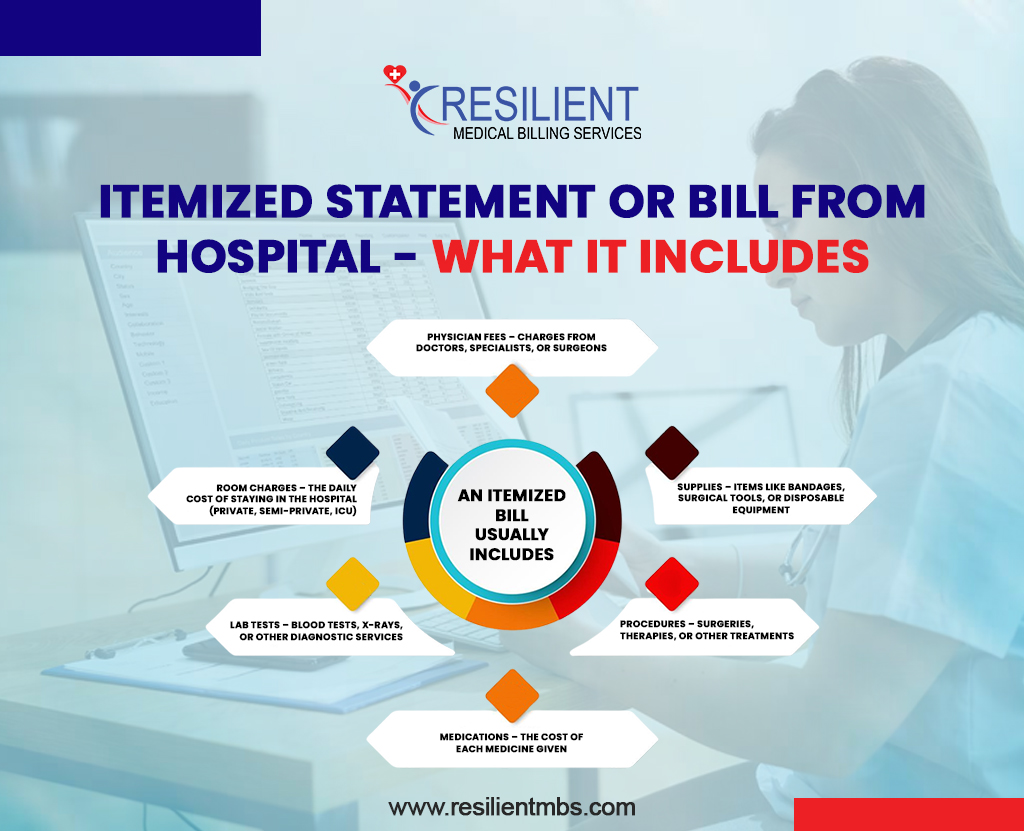Medical bills can be confusing and stressful. Many patients see numbers and codes on a bill and don’t know what they mean. That’s why it’s essential to have clear and easy-to-understand billing.
An itemized bill in medical billing helps with this. It lists every service, supply, or procedure you received, showing precisely what you are being charged for. By looking at an itemized bill, patients can avoid surprises, understand their costs, and feel more in control of their healthcare expenses.
What is an Itemized Bill in Medical Billing?
An itemized bill is a detailed list of charges you get from a hospital or clinic. Instead of just showing the total amount, it breaks down every service, including lab tests, medicines, supplies, and doctors’ fees, along with their costs.
This differs from a summary bill, which only displays the total without providing details. With an itemized bill, you can clearly see what you are paying for, making the billing process more transparent.
Why Itemized Bills Are Important
Spot mistakes: Hospitals handle a large number of patients daily, and errors such as duplicate charges can occur. An itemized bill makes them easier to find.
Check your care: You can compare the bill to the services you actually received and question anything that looks wrong.
Help with Insurance Claims: Insurance companies often require itemized bills to process payments or appeals.
Increase transparency: With rising healthcare costs, itemized bills provide a clear view of how your money is being spent.
Itemized Statement in Medical Billing
An itemized statement in medical billing is a detailed list of all the medical services, tests, medications, and supplies you received, along with their costs. Unlike a regular bill that only displays the total amount, an itemized statement breaks down each charge separately.
This helps you see exactly what you are paying for, spot any mistakes, and make sure your insurance covers the right services. You can request an itemized statement from your hospital or clinic at any time, providing a clear breakdown of your healthcare expenses.
Itemized Statement or Bill from Hospital – What It Includes
An itemized bill usually includes:
- Room charges – the daily cost of staying in the hospital (private, semi-private, ICU).
- Lab tests – blood tests, X-rays, or other diagnostic services.
- Medications – the cost of each medicine given.
- Procedures – surgeries, therapies, or other treatments.
- Supplies – items like bandages, surgical tools, or disposable equipment.
- Physician fees – charges from doctors, specialists, or surgeons.

Example of an itemized bill:
- Room: $1,500 (3 days @ $500/day)
- Lab tests: $350 (blood work, X-ray)
- Medications: $200 (antibiotics, pain relief)
- Surgery: $2,500
- Physician fees: $1,000
By reviewing an itemized bill, patients can verify that the charges are accurate, identify any errors, and prevent overpaying.
Patients’ Right to Itemized Medical Bill
Patients have the right to request an itemized bill, which details every charge. In the U.S., laws like the No Surprises Act and state rules make it clear that hospitals and clinics must provide this bill if you request it. Other countries, such as the UK, Australia, and Canada, also require healthcare providers to share detailed invoices for private or insurance-covered care.
Why an Itemized Bill Matters
- You can spot mistakes or extra charges.
- It gives proof for insurance claims or reimbursements.
- It helps you understand what you’re paying for.
Steps to Request an Itemized Medical Bill
- Contact the hospital or clinic’s billing department; however, writing your request is best.
- Ask patient services or advocacy teams for extra help if needed.
- Clearly state that you are requesting an “itemized medical bill” and include the dates of your care.
- Keep copies of all bills, letters, and receipts for your records.
- Compare the bill with your insurance Explanation of Benefits (EOB) and medical records.
If you notice errors, reach out to the billing office or your insurance company right away. Reviewing your bill carefully can prevent overpayment and save you money.
Common Errors in Itemized Bills
Itemized medical bills are helpful, but they often contain errors that can result in additional costs for patients.
Some common problems are:
- Duplicate charges: Being billed twice for the same service.
- Coding mistakes: Wrong medical codes that raise costs or cause insurance issues.
- Services not received: Charges for tests, treatments, or medicines you never got.
- Upcharges: Being billed for a more expensive service or supply than the one actually used.
To protect yourself, check your bill line by line. Compare it with your medical records or your Explanation of Benefits (EOB). If something doesn’t look right, contact the hospital or the provider’s billing office. If the problem isn’t fixed, reach out to your insurance company for help.
Why Reviewing Itemized Bills Matters
Looking closely at your bill has tangible benefits:
- Save money by catching errors and avoiding overpayment.
- Build trust by asking providers to explain unclear charges.
- Plan by understanding your actual medical costs.
Reviewing your bills helps you stay informed, avoid unfair charges, and make smarter healthcare decisions.
Concluding Words
An itemized bill is more than just a list of charges; it shows exactly what you’re paying for and why. Checking your bill carefully can help you spot mistakes, avoid overpaying, and take control of your healthcare costs.
Always ask for an itemized bill whenever you get medical care. It protects your money and helps you better understand your care.
For help spotting billing errors and managing claims, contact Resilient MBS today.
FAQs
What is an itemized bill in medical billing?
An itemized bill is a detailed list of all the medical services, tests, medications, and supplies for which you were charged. Unlike a simple summary bill, it breaks down each cost separately, allowing you to see exactly what you’re paying for.
Why should I ask for an itemized medical bill?
Requesting an itemized bill helps you identify mistakes, prevent overpayment for items you didn’t receive, and better understand your charges. It also makes it easier if you need to file a claim with your insurance company.
How can I request an itemized bill from a hospital or clinic?
You need to contact the hospital’s billing office or patient services and request one. It’s your right as a patient to receive a clear, detailed bill.
What mistakes are often found in itemized bills?
Common mistakes include being charged twice for the same service, charges for treatments you didn’t get, or incorrect prices. Checking your bill carefully can save you money.
Do I have the right to an itemized medical bill?
Yes, you do. Patients have the right to request an itemized bill, and hospitals or clinics must provide it when asked. This helps make healthcare costs more transparent and fair.











